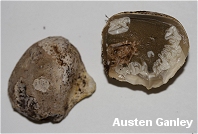| Major Groups > Stinkhorns > Ileodictyon cibarium |

|
Ileodictyon cibarium [ Basidiomycota > Phallales > Clathraceae > Ileodictyon . . . ] by Michael Kuo Ileodictyon cibarium is primarily known from New Zealand and Australia, though it has also been recorded in Africa, Europe, and South America. It is a stinkhorn, but it might better be labeled a "stink cage," since there isn't anything horn-like about it. Clathrus ruber and similar species of Clathrus also form cage-like structures, but they remain rooted to the substrate; Ileodictyon cibarium detaches itself from its base. Additionally, its branches are white, rather than red to orange. Ileodictyon gracile is a similar species with slender, more graceful arms. Thanks to Austen Ganley for documenting, collecting, and preserving Ileodictyon cibarium for study; his collection is deposited in The Herbarium of Michael Kuo. Thanks to the Oregon State University Herbarium for facilitating study of the collection cited below. Description: Ecology: Saprobic; growing alone or gregariously in woods or in cultivated areas; appearing year-round; originally described from New Zealand; found in Oceania, South America, Africa, and Europe. The illustrated and described collections are from New Zealand and Australia. Immature Fruiting Body: A whitish "egg" 2–5 cm high and 2–5 cm wide; surface smooth; when sliced revealing the stinkhorn-to-be encased in a gelatinous substance, with the future arms packed accordion-like; base attached to white rhizoids. Mature Fruiting Body: A more or less round, cage-like structure, 5–10 cm across and 5–10 cm high, forming 10–20 polygons; arms lumpy, about 1 cm in diameter, not thickened at the intersections, white; spore slime formed on the inner surfaces of the arms, olive brown; the egg tissue creating a whitish to purplish volva, but the mature structure often detaching from it. Odor: Foul while the spore slime is present. Microscopic Features: Spores 4.5–5.5 x 2–3 µm; ellipsoid; smooth; hyaline in KOH. Sphaerocysts of the pseudostipe 17–28 µm across; subglobose unless compressed, and then irregular; walls 1 µm thick; smooth; hyaline in KOH. Hyphae of the volva 4–10 µm wide; encrusted; brown in KOH. REFERENCES: L. R. Tulasne, 1844. (Saccardo, 1888; Lloyd, 1909; Cunningham, 1944/1979; Dring, 1980; Hosaka et al., 2006; Coetzee, 2010; Buczacki et al., 2013; Sandoval-Leiva et al., 2014; Trierveiler-Pereira et al., 2014; Kibby, 2017.) Herb. Kuo 07041201. Herb. OSC 107652. This website contains no information about the edibility or toxicity of mushrooms. |
© MushroomExpert.Com |
|
Cite this page as: Kuo, M. (2022, July). Ileodictyon cibarium. Retrieved from the MushroomExpert.Com Web site: http://www.mushroomexpert.com/ileodictyon_cibarium.html |




